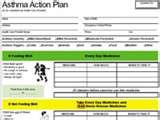In the November 19th post I discussed some of the common household asthma triggers. Triggers are usually pollutants found throughout the home that can elicit asthma symptoms in children and adults resulting in acute episodes.
As we always suggest, first consult with your doctor to create an individual Asthma Action Plan which should address the triggers that create acute attacks.
Three common household triggers discussed recently were Mold, Nitrogen Dioxide and Pets (see: http://regalfabriccare.com/2009/11/asthma-whats-a-parent-to-do-part-one/). Today I’ll be covering three more triggers that you want to be aware of. Once recognized you may want to include as part of your child’s Asthma Action Plan.
Call us to see how our carpet, upholstery and drapery cleaning may be able to eliminate or reduce the triggers in you home and office. Safe and effective elimination of dust mites, smoke residue and other causes of acute asthma episodes can help your family enjoy all areas of your home. For more information on Safe Cleaning visit Designed for the Environment (dfE).
Three additional asthma triggers are:
- Secondhand smoke
- Dust mites
- Cockroaches
Secondhand Smoke:
Secondhand smoke, also known as Environmental Tobacco Smoke (ETS), consists of exhaled smoke from smokers and side stream smoke from the burning end of a cigarette, cigar or pipe. According to the U.S. EDA secondhand smoke contains more than 4,000 substances, including several compounds that are known carcinogens.
Secondhand smoke can trigger asthma episodes and increase the severity of attacks. Preschool aged children are also at risk of developing asthma from secondhand smoke. Scientists believe that secondhand smoke irritates the chronically inflamed bronchial passages of people with asthma.
PARENTS: Most of the health effects of smoke are seen in children probably because a child’s developing lungs make them more susceptible and also because of their smaller size they breathe more rapidly thus taking in a greater volume of smoke. Children receiving high doses of secondhand smoke, such as those with smoking parents, are more at risk of experiencing damaging health effects.
Dust mites ( http://regalfabriccare.com/2009/11/dust-mites-is-there-a-solution/ )
Dust mites are tiny insects that are invisible to the naked eye. Every home has dust mites. They feed on human skin flakes and pet dander and are usually found in mattresses, pillows, carpets, upholstered furniture, bed covers, clothes, stuffed toys and fabric and fabric-covered items (upholstery). Body parts and feces from dust mites can trigger asthma in individuals with allergic reactions to dust mites, and exposure to dust mites can cause asthma in children who have not previously exhibited asthma symptoms.
Actions that may be helpful:
- Cover mattresses and pillows with dust proof (“allergen-impermeable”) zippered covers. Blankets, sheets and other bed-covers should be washed weekly in hot water.
- Stuffed Toys-allow only washable stuffed toys in the home. Wash then weekly in hot water-remeber to keep them dry and off the bed.
- Maintain low indoor humidity, ideally between 30-50% relative humidity. Humidity levels can be measured by hygrometers which are available at local hardware stores.
- Maintain the homes mechanical systems-proper heating and A/C operation will help maintain a comfortable relative humidity level.
Also:
- Remove dust often with a damp cloth. more on DUST
- Vacuum carpet and fabric-covered furniture to reduce dust build-up.
- Using vacuums with high efficiency (H.E.P.A.) filters or central vacuums may be helpful. People with asthma or allergies should leave the area being vacuumed.
Cockroaches
Cockroach droppings can trigger asthma episodes. Certain proteins, called allergens, are found in cockroach feces and saliva and can cause allergic reactions, or trigger asthma symptoms, in some individuals. Cockroaches are commonly found in crowded cities and the southern regions of the United States. Cockroach allergens likely play a prominent role in asthma in many inner-city areas. Infants, due to their proximity to the floor where cockroaches are found can be especially vulnerable.
Actions You May Take
An important aspect of pest management is to remove places in your home for pests to hide and to keep exposed areas free of food and water (spills and even pet dishes). Pesticides: Are not only toxic to pests, they can harm people too. Try to use pest management methods that pose less of a risk. Tips to prevent pests:
- Do not leave food or garbage out (even for your own pets).
- Store food in airtight containers.
- Clean all food crumbs or spilled liquids right away.
- Keep the kitchen sink free of dirty dishes.
- Keep counters, sinks, tables and floors clean and clear of clutter.
- Fix plumbing leaks and other moisture problems.
- Seal cracks or openings around or inside cabinets.
- Remove piles of boxes, newspapers and other hiding places for pests from your home, including patios and three season porches.
- Make sure trash is stored in containers with lids that close securely, and remove trash daily.
- Try using poison baits, boric acid or traps first before using pesticide sprays.
- If sprays are used:
Limit the amount of spray to the affect area only, don’t spray near food or food preparation areas and follow the manufacturer’s label instructions-If unsure, contact a professional pest management firm.
We are always available to help you maintain a “trigger” free home through proper cleaning of your soft furnishings: Oriental Rugs, Carpeting, Upholstery, Drapery…even your child’s stuffed toys.
I hope you found this information helpful-I welcome your comments………..David Mavilio david.mavilio@regalclean.com
Wishing you “a Clean, Healthy Home ( & OFFICE)…ALWAYS!”




